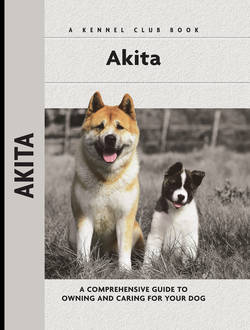Читать книгу Akita - Barbara J. Andrews - Страница 2
На сайте Литреса книга снята с продажи.
ОглавлениеPhysical Characteristics of theAkita
(from the the American Kennel Club
breed standard)
Ears: Strongly erect and small in relation to rest of head. Triangular, slightly rounded at tip, wide at base, set wide on head but not too low, and carried slightly forward over eyes in line with back of neck.
Eyes: Dark brown, small, deep-set and triangular in shape. Eye rims black and tight.
Nose: Broad and black. Liver permitted on white Akitas, but black always preferred.
Head: Massive but in balance with body; free of wrinkle when at ease. Skull flat between ears and broad; jaws square and powerful with minimal dewlap.
Muzzle: Broad and full. Distance from nose to stop is to distance from stop to occiput as 2 is to 3.
Stop: Well defined, but not too abrupt. A shallow furrow extends well up forehead.
Forequarters: Shoulders strong and powerful with moderate layback. Forelegs heavy-boned and straight as viewed from front. Angle of pastern 15 degrees forward from vertical.
Color: Any color including white; brindle; or pinto. Colors are brilliant and clear and markings are well balanced, with or without mask or blaze. White Akitas have no mask. Undercoat may be a different color from outer coat.
Neck: Thick and muscular; comparatively short, widening gradually toward shoulders. A pronounced crest blends in with base of skull.
Tail: Large and full, set high and carried over back or against flank in a three-quarter, full, or double curl, always dipping to or below level of back. Root large and strong. Hair coarse, straight and full, with no appearance of a plume.
Body: Longer than high, as 10 is to 9 in males; 11 to 9 in bitches. Chest wide and deep; depth of chest is one-half height of dog at shoulder. Ribs well sprung, brisket well developed. Level back with firmly-muscled loin and moderate tuck-up. Skin pliant but not loose.
Coat: Double-coated. Undercoat thick, soft, dense and shorter than outer coat. Outer coat straight, harsh and standing somewhat off body.
Hindquarters: Width, muscular development and bone comparable to forequarters. Upper thighs well developed. Stifle moderately bent and hocks well let down, turning neither in nor out.
Dewdaws: On front legs generally not removed; dewclaws on hind legs generally removed.
Feet: Cat feet, well knuckled up with thick pads. Feet straight ahead.
Size: Males 26 to 28 inches at the withers; bitches 24 to 26 inches.
